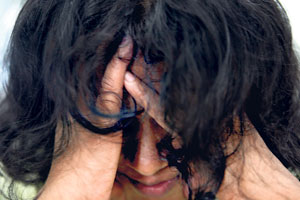Depression is the commonest mental illness affecting Sri Lankans, with nearly 10 in every 100 (10 %) suffering from form of this condition.
Whereas earlier, the stress was on post-traumatic stress disorder, current scientific findings debunk this myth and point a conclusive finger towards depression in its varying forms.
The findings are an eye-opener.
- Two in every 100 Sri Lankans (2.1%) have major depressive syndrome or depression
- Seven in every 100 (7.1%) have minor depression, bipolar disorders and dysthymia
- Three in every 100 (3%) have medically unexplained symptoms (somatoform disorder)
- Nearly 2 in every 100 (1.7%) have post-traumatic stress syndrome
- One in every 100 (1.4%) have anxiety and panic disorder
- Eating disorders are negligible
- A crucial finding was that 1.6% had active suicidal ideas or thoughts.
- Mental illness prevalence is highest in Puttalam and Moneragala, on a district-basis
These facts, casting new light on the mental state of Sri Lankans, have been gathered through the first-ever islandwide National Mental Survey commissioned by the Ministry of Health and conducted by the Institute for Research and Development (IRD). Carried out in 2007, the findings have been handed over to the ministry at the end of last year.
This baseline survey which included a population-based study, a school-based study and the attitudes of different strata of society towards mental health was conducted to ascertain prevalence and geographical distribution, says IRD Director Dr. Athula Sumathipala who is a well-known psychiatrist here and abroad.
“The numbers are needed to plan services,” he stresses, adding that in most developing countries, service planning is usually based on assumption. Even hospital records are not a true reflection of the numbers, as due to the stigma attached to mental illness, most people do not go to hospital but suffer in silence.
Referring to the logistics of conducting such a wide survey in a systematic and scientific manner, Dr. Sumathipala says the IRD with its capability in terms of expertise and human resources, trained over 50 researchers who fanned out across the country and over 100 teachers, in collaboration with the National Institute of Education, Maharagama for the school-based survey.
More than 6,000 randomly-selected people in all provinces – including 24 Grama Niladhari divisions affected by the tsunami and also border villages – other than the north and the east and 4,000 schoolchildren from different categories of schools were surveyed, The Sunday Times understands.
“We had planned to survey the north and the east too but the escalation of war prevented this. However, we have included Tamil-speaking people from Puttalam, Colombo and Nuwara Eliya (more than 50% here were Tamils),” he explains.
Lauding the team which handled the nitty-gritty, Dr. Sumathipala says that one of the youngest researchers at IRD, Dr. Suwin Hewage, coordinated the project while Dr. Sisira Siribaddana, a physician with a special interest in mental health coordinated the day-to-day activity. While NIE Director Dr. Godwin Kodithuwakku coordinated the school survey, IRD executive members Dr. Sudath Samaraweera and Dr. Nihal Abeysinghe also made major contributions. Former Mental Health Director Dr. Hiranthi de Silva had also extended much support.
The study was executed for an unimaginably low Rs. 40 lakhs which covered expenses of research assistants and other resources. No consultancy fees were charged by the IRD team – working in collaboration with experts from the Institute of Psychiatry, King’s College -- which designed and carried out the study, The Sunday Times learns. The funds had been allocated from the ministry’s Health Sector Development Project.
“Sri Lanka has had 30 years of war, experienced two uprisings and faced a devastating tsunami. The impression was that many stressful events may have contributed to mental health issues,” explains Dr. Sumathipala, adding that the survey has clearly shown that post-traumatic stress disorder is nowhere near what was assumed. “It had been predicted as being high. It had also been given undue prominence and priority at the expense of the real problem which is depression.”
Although the survey was not mandated to study psychosis (insanity in lay terms), it found an estimated 1%, according to him.
What next?
The next step would be service development based on the findings of this National Survey, says Dr. Sumathipala, adding that although mental health figures are not overly high, they should not be ignored.
“We have only 20 psychiatrists and it is impossible to provide an exclusive consultant-based mental health service. Therefore, a multidisciplinary outlook is important with middle-grade experts and others including nurses, social workers and volunteers mobilised at community level,” he said.
Establishment and development of community mental health resources along with the input of carers and users, are the needs of the country’s mentally-ill people, stressed Dr. Sumathipala, commending the appointment of well-known and experienced Psychiatrist Dr. Neil Fernando to oversee this aspect.
Whereas earlier services were rendered and priorities established on assumptions, now that the facts and real figures are in a large tome on the table, there is hope for the mentally-ill in Sri Lanka.
What about our schools?
The school-based survey not only looked at the mental health status but also such issues as absenteeism which was recorded at 17% among those surveyed, The Sunday Times understands.
Explaining that children’s mental health issues manifest themselves in a manner different to signs of classical depression found in adults, Dr. Sumathipala said they were reflected as conduct problems, hyperactivity and peer problems.
A three-dimensional picture was taken from the point of view of schoolchildren, teachers and also parents.
The findings:
- 5.5% have emotional problems
- 6.9% have conduct problems
- 4.9% are hyperactive
- 4.7% have peer issues
Teachers, however, had seen the numbers of children with emotional problems as being as high as 10% and parents even higher. ‘The findings, therefore, need to be analyzed,” he adds. |

